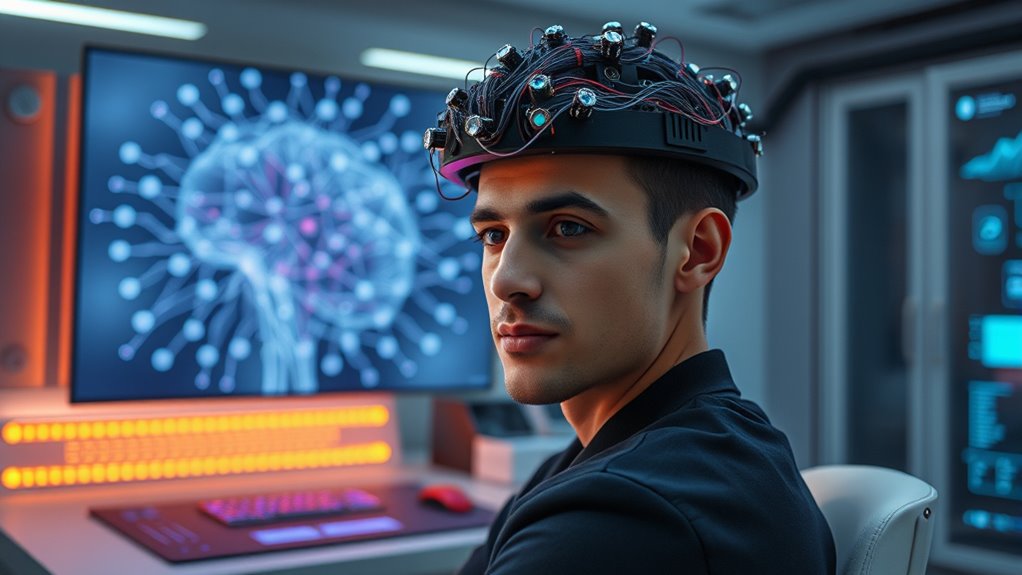Brain-computer interfaces (BCIs) are rapidly moving from science fiction to reality by enabling direct links between your brain and external devices. Advances in neural decoding, signal processing, and sensor technology are making BCIs more accurate, responsive, and safe. While ethical issues like privacy and consent are vital, ongoing research aims to develop responsible solutions that improve lives. To see how science is turning these concepts into everyday tools, explore further insights behind this exciting technology.
Key Takeaways
- Current BCIs rely on real neural signals and proven sensor technologies, not on fictional or speculative concepts.
- Advances in algorithms and machine learning improve neural decoding, moving beyond sci-fi portrayals of mind-reading.
- Ethical frameworks and data privacy standards help distinguish practical applications from science fiction scenarios.
- Long-term, durable, biocompatible materials support safe and reliable device integration, unlike sensationalized sci-fi devices.
- Responsible research emphasizes transparency and human rights, ensuring BCIs serve real needs rather than speculative or dystopian ideas.

Brain-Computer Interfaces (BCIs) are systems that enable direct communication between your brain and external devices. These interfaces work by translating neural activity into commands that computers can understand, opening up a world of possibilities for control and communication. At the core of this process lies neural decoding, which involves interpreting the electrical signals generated by your brain’s neurons. This step is crucial because it determines how accurately your intentions are translated into actions. Advances in neural decoding algorithms have made it possible to interpret complex neural patterns with increasing precision, leading to more responsive and intuitive BCI systems. Additionally, ongoing research into material durability ensures that BCI devices remain reliable and safe over extended periods of use. As technology progresses, neural signal processing techniques continue to improve, enhancing the efficiency of BCIs. Moreover, innovations in biocompatible materials are helping to minimize the risk of adverse reactions and improve long-term device integration. Researchers are also exploring advanced sensor technology to further refine neural data collection and improve decoding accuracy. Furthermore, integrating machine learning algorithms can significantly boost the ability to interpret neural signals with greater nuance. However, as these technologies become more sophisticated, ethical considerations come to the forefront. You might wonder about privacy, consent, and the potential for misuse. For example, if neural signals can be read and interpreted, questions arise about who owns that data and how it should be protected. There’s also concern about the possibility of unauthorized access to neural information, which could compromise personal privacy or lead to manipulation. These ethical dilemmas demand careful regulation and transparent development practices. As you explore BCI applications, you’ll notice that developers often emphasize the importance of informed consent, ensuring users understand the risks and benefits involved. Additionally, researchers are working to establish standards for data security and privacy to prevent malicious hacking or unauthorized data collection. The intersection of neural decoding and ethical considerations isn’t just theoretical; it impacts real-world deployment. For instance, in medical settings, BCIs can restore mobility or communication for individuals with paralysis or neurological disorders. But even in these cases, ethical questions about autonomy and consent are critical to address. As technology advances, the line between science and science fiction blurs, making it essential for you to stay informed and engaged in ongoing debates. While BCIs hold incredible promise for improving quality of life, they also challenge existing notions of privacy and human rights. Responsible development means prioritizing transparency, ethical standards, and user rights as these systems become more integrated into everyday life. In essence, neural decoding is the engine driving BCI progress, but it must be balanced with a thoughtful approach to the ethical considerations that ensure such innovations benefit society without infringing on personal freedoms. As you consider the future of BCIs, remember that responsible innovation is key to transforming science fiction visions into safe, ethical realities.
Frequently Asked Questions
Can Brain-Computer Interfaces Read Thoughts Directly?
You might wonder if brain-computer interfaces can read thoughts directly. While they can interpret certain brain signals and infer intentions, true mind reading remains science fiction. These devices raise privacy concerns, as they could potentially access private thoughts without permission. For now, BCI technology is limited to detecting neural activity related to specific tasks, not fully deciphering your inner thoughts, keeping the line between science and sci-fi clear.
Are Brain Implants Safe for Long-Term Use?
Like a fragile thread spun between safety and risk, brain implants pose significant questions. You should know that their long-term safety remains uncertain due to ethical concerns and technological limitations. While advancements are promising, ongoing research highlights potential issues like infections or device failure. As you consider these implants, stay informed about evolving studies, because understanding the risks helps ensure your choices align with safety and ethical standards.
How Much Do Brain-Computer Interfaces Cost?
You might wonder about the cost feasibility and market accessibility of brain-computer interfaces. Currently, prices vary widely, with experimental setups costing tens of thousands and more advanced, FDA-approved devices reaching hundreds of thousands. While costs are high, ongoing research aims to make BCI technology more affordable and accessible, expanding market reach. As technology advances, expect prices to decrease, improving accessibility for more users.
Will BCIS Replace Traditional Communication Methods?
You might think BCIs will completely replace traditional communication, but ethical dilemmas and privacy concerns make that unlikely soon. While BCIs can enhance communication, they’re not perfect and raise issues about mind privacy and consent. Instead of replacing, they’ll likely complement existing methods, offering new possibilities. You’ll want to stay informed about these developments, understanding that technology advances gradually, balancing innovation with ethical considerations.
Can BCIS Enhance Cognitive Abilities Beyond Normal Limits?
You wonder if BCIs can boost your cognitive abilities beyond normal limits. While neuroplastic enhancement and cognitive augmentation are promising, current technology mainly supports communication and control. Future advancements might enable real-time mental enhancements, but ethical and safety concerns remain. For now, BCIs are more about restoring functions rather than surpassing natural cognitive limits, so don’t expect them to make you superhuman just yet.
Conclusion
As you step into the domain of brain-computer interfaces, remember they’re like bridges between mind and machine—powerful yet still under construction. While science is peeling back the layers of sci-fi fantasies, the journey is just beginning. Keep your eyes open; this technology is a wild garden of promise and challenge. With each breakthrough, you’re witnessing a future where thoughts can dance directly into devices—transforming dreams into reality, one neural spark at a time.
Amina brings over a decade of journalism experience to her role as Editor-in-Chief. Under her leadership, Exquisite Post has flourished, maintaining the highest standards of integrity and excellence. Amina’s commitment to truth and her visionary approach guide the editorial team in producing impactful news stories that resonate with our audience.










